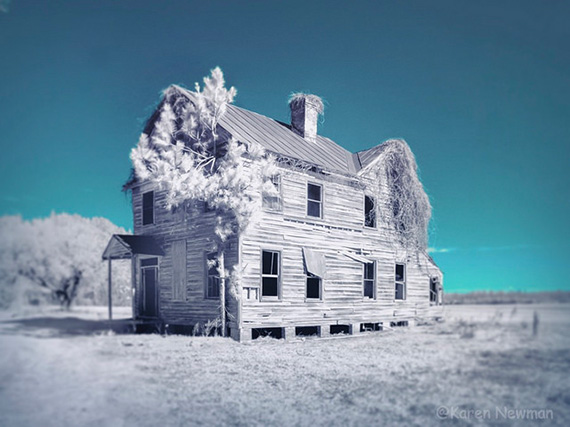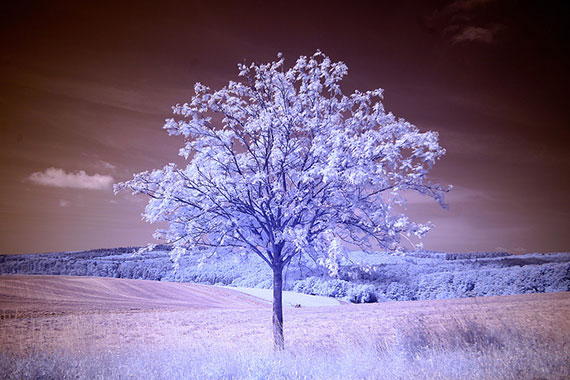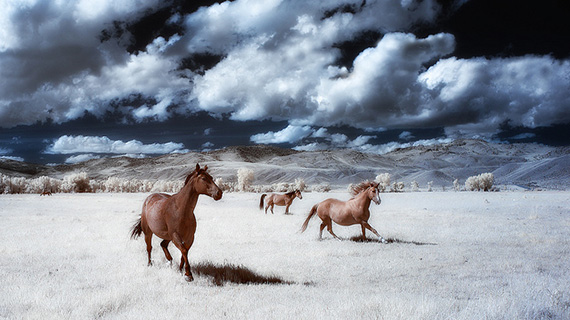Infrared, or IR, is a form of light wave that is not visible to the human eye. In the electromagnetic spectrum, IR waves are grouped between visible light and radio waves. Being invisible, how is infrared used in photography?

photo by Karen Newman Photography
It is indeed utilized, not only by photographers, but by scientists and technicians as well. Infrared photography produces images that are not achieved by commonly-used films. Today, infrared digital photography enthusiasts like to refer to their hobby as taking pictures with invisible light.
IR photography is unusual in the sense that it relies on the ability of the camera to record what is not visible to the eye by capturing infrared radiation instead of visible light. IR waves can penetrate certain kinds of haze or cloud cover so that pictures of objects, which are distant or are not visible to the normal camera, can be taken. Further, IR can also make visible the long-wavelength heat emitted by objects. This is why infrared digital photography is very important to astronomers and physicists.

photo by Mark Strobl
Infrared photography is not a new technique. It has been around for many years, but only very few photographers used it with film, because it was expensive and difficult. When digital cameras came along, IR photography became significantly cheaper and easier.
Camera Modification
The CCD and CMOS sensors of your digital camera have the ability to capture infrared light. However, the manufacturer puts a filter in front of the sensor to block out ultraviolet and infrared rays, because these can interfere with recording images. If you want to take IR photos, and have a camera that you will no longer use for capturing normal images, you can remove the blocking filter and let a wider range of light waves hit the sensor. Some photographers attempt this modification at home, but there are services that will do this conversion for a fee. Taking unfiltered shots requires certain adjustments to your camera, but these can be easily made with digicams since you can view images instantly and make any necessary adjustments as you go. For more info we have an article on getting started in infrared photography.

photo by greg westfall
IR Filters
Another infrared digital photography method involves placing an IR filter in front of the lens without removing the sensor filter. While less intrusive, using an infrared filter may be less advantageous than using a converted camera. Because incoming light is filtered, capturing images takes longer. Further, an external filter hinders the photographer’s view, making it difficult to compose and focus.
The video below is a tutorial for those interested in working with infrared filters:
Infrared photographs appear very different from pictures taken with visible light. Clouds appear more interesting, because they reflect more IR rays than the sky. Leaves and plants appear very bright, so care must be taken not to overexpose them. Colors do not look the same as in the real world, and even similarly colored objects may look vastly different. Some photographers like using infrared in portraits because it causes the skin to look very smooth.
With today’s advancements in technology, you can tweak your camera’s features and extend its capabilities. Why don’t you experiment and create amazing shots using infrared digital photography?
About the Author:
Tommy Coffler writes for Beginner’s Photography Guide (photographybeginnersguide dot com). The more you use your camera, the more tips and tricks for digital photography you will learn.
Go to full article: How to Do Infrared Photography
What are your thoughts on this article? Join the discussion on Facebook
PictureCorrect subscribers can also learn more today with our #1 bestseller: The Photography Tutorial eBook
The post How to Do Infrared Photography appeared first on PictureCorrect.
from PictureCorrect https://ift.tt/2rUQIta
via IFTTT






0 kommenttia:
Lähetä kommentti